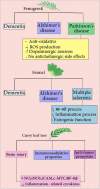From kitchen to clinic: Pharmacotherapeutic potential of common spices in Indian cooking in age-related neurological disorders
- PMID: 36438833
- PMCID: PMC9685814
- DOI: 10.3389/fphar.2022.960037
From kitchen to clinic: Pharmacotherapeutic potential of common spices in Indian cooking in age-related neurological disorders
Abstract
Aging is described as an advanced time-related collection of changes that may negatively affect with the risk of several diseases or death. Aging is a main factor of several age-related neurological disorders, including neurodegenerative diseases (Alzheimer's disease, Parkinson's disease, and dementia), stroke, neuroinflammation, neurotoxicity, brain tumors, oxidative stress, and reactive oxygen species (ROS). Currently available medications for age-related neurological disorders may lead to several side effects, such as headache, diarrhea, nausea, gastrointestinal (GI) diseases, dyskinesia, and hallucinosis. These days, studies on plant efficacy in traditional medicine are being conducted because herbal medicine is affordable, safe, and culturally acceptable and easily accessible. The Indian traditional medicine system called Ayurveda uses several herbs and medicinal plants to treat various disorders including neurological disorders. This review aims to summarize the data on the neuroprotective potential of the following common Indian spices widely used in Ayurveda: cumin (Cuminum cyminum (L.), Apiaceae), black cumin (Nigella sativa (L.), Ranunculaceae), black pepper (Piper nigrum (L.), Piperaceae), curry leaf tree (Murraya koenigii (L.), Spreng Rutaceae), fenugreek (Trigonella foenum-graecum (L.), Fabaceae), fennel (Foeniculum vulgare Mill, Apiaceae), cardamom (Elettaria cardamomum (L.) Maton, Zingiberaceae), cloves (Syzygium aromaticum (L.) Merr. & L.M.Perry, Myrtaceae), and coriander (Coriandrum sativum (L.), Apiaceae) in age-related neurological disorders.
Keywords: Indian spices; aging; complementary medicine; herbal extracts; neurological disorder.
Copyright © 2022 Norouzkhani, Karimi, Badami, Jalalifar, Mahmoudvand, Ansari, Pakrou Sariyarighan, Alijanzadeh, Aghakhani, Shayestehmehr, Arzaghi, Sheikh, Salami, Marabi, Abdi and Deravi.
Conflict of interest statement
The authors declare that the research was conducted in the absence of any commercial or financial relationships that could be construed as a potential conflict of interest.
Figures




References
-
- Agnoli A., Fazio C. (1977). Platelet aggregation in the pathogenesis of cerebrovascular disorders. Berlin, Germany: Springer.
Publication types
LinkOut - more resources
Full Text Sources

